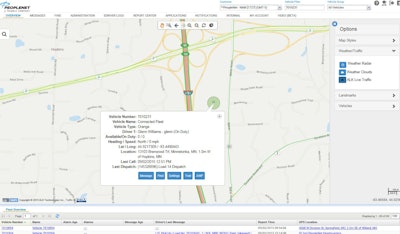Editors note: this is the fourth and final article in a series about technology that increases fuel efficiency and safety beyond speed governing. Click here to see parts one, two and three.

The FMCSA estimates the rule will save $605 million in fuel for combination vehicles, straight trucks and buses, and this will be more than enough to make up for the lost productivity by governing trucks to either 60, 65 or 68 mph.
As noted in previous articles in this series, speed limiters are entry-level technology for fleet safety and fuel efficiency. Advanced telematics and Internet of Things systems are giving fleets valuable insights on speed behaviors and fuel economy that can yield greater results than governing the top speed.
Below are three areas where the direction of technology is going:
1. Gamification
A number of systems give drivers automated feedback through mobile devices, which include easy-to-understand scores and competitions to earn rewards and recognition.
 Vnomics calculates a daily score for drivers that shows how they performed compared to their potential.
Vnomics calculates a daily score for drivers that shows how they performed compared to their potential.Vnomics designed its fleet management platform to give distinct audible tones when drivers exceed thresholds for top speed and RPMs. Drivers also get a daily score that shows their fuel and safety performance in relation to what they could have achieved by staying within the optimal range.
Fleet managers can also receive immediate e-mail alerts for excessive speed events, says Bob Magnant, vice president of product management at Vnomics.
A web-based fleet management portal shows simplified metrics for driver speed, shifting, hard braking events and engine idling behaviors. The metrics account for the frequency and severity of events and show the associated fuel loss for each, he says.
The Vnomics platform calculates fuel loss by modeling the performance of the engine. Its algorithms determine the mpg drivers could have achieved compared to their actual results.
 Azuga’s fleet management system has a mobile app that gives drivers a scorecard with incentives.
Azuga’s fleet management system has a mobile app that gives drivers a scorecard with incentives.The full version of Vnomics’ telematics system provides a visual display to drivers with the scores and other applications such as electronic logs. The company has a slimmed down product version, True Fuel, that gives audible tones and communicates scores to drivers verbally, he says, without an in-cab display.
Azuga’s telematics platform is primarily used by fleets with light and medium-duty vehicles. Its mobile application shows drivers a safety score and leaderboard, which they use daily to primarily improve their speeding and hard braking behaviors.
Azuga has built-in driver incentive programs that fleets use to send gift cards to their high performing employees and contractors.
In addition, the company’s team of data scientists can create custom reports for fleets to show more context for speed behaviors. For instance, the team has identified unsafe driver speed behaviors in relation to risky intersections and weather conditions.
The data scientists have calculated what it costs in fuel for hard braking events for light and medium-duty vehicles. Each event burns between .05 and .08 gallons of fuel, depending on severity. With an average of six to 10 hard brakes per day, improper spacing in traffic costs fleets a couple of gallons per month extra in fuel, says Ananth Rani, Azuga’s founder and president.
2. Speed analytics
Telematics systems can do more than report on violations of the max speed. Many have integrated their speed and location data with SpeedGauge, a provider of business intelligence and location-based analytics, to know how their drivers complied with posted speed limits along their routes, on and off-highway.
 PeopleNet has a big data analysis portal, Central Intelligence, to take a closer look at driver performance behaviors, including speed.
PeopleNet has a big data analysis portal, Central Intelligence, to take a closer look at driver performance behaviors, including speed.Besides integrating with SpeedGauge, PeopleNet — provider of fleet mobility and telematics — continues to look at opportunities to augment its reporting of driver speed, among other performance behaviors, says Eric Witty, vice president of product for PeopleNet.
One opportunity is to use its Video Intelligence system to capture data from road signs as well as use integration with in-cab navigation applications, like ALK Co-Pilot, to give real-time feedback to drivers for posted speed limits, he says.
“We look at what technology is on the truck, and how to integrate it to provide the best answer on what safety problem a driver is having,” he says.
Teletrac is focused on driver scorecards and safety analytics for its telematics platform.
“The focus is to provide data in more holistic way than speed,” says Sid Nair, senior director of marketing and product management.
Using Teletrac’s driver scorecard, a manager can drill down to an interactive mapping tool to identify exactly where on the route a driver has been speeding. The tool can replay the driver’s speed profile to identify where a driver sped, had a harsh braking event, or jumped a stop sign, among other behaviors, he says.
Teletrac includes turn-by-turn navigation in its system. This gives drivers instant alerts if they exceed posted speed.
“There is no more excuse about not knowing what the speed is at any time,” he says.
3. Video analytics
Video-based safety systems can capture a video of risky driving events using speed and other triggers. Some of these systems can also give drivers a speed warning to help prevent them from exceeding a top speed limit.
To understand the impact of speed warnings on drivers, CCJ recently asked companies which offer video-based safety and risk management platforms to analyze the speed behavior changes realized by clients using their technology.

A sampling of data from 25 over-the-road trucking clients for the last 15 months, including 10 clients in the process of deploying the Lytx system, showed the following:
- In the immediate six months following deployment, Lytx DriveCam trial clients are seeing an average of 69 percent reduction in Speed Violations.
- Many of its long tenured clients, running good programs, have Speed Violations down to 2-6 Violations per 100 Vehicles Per Month. For comparison, new trials are running on average 27 speed violations per 100 vehicles per month.
- Existing clients who turn speed triggering on have seen an additional reduction of 33 percent in the first six months.
SmartDrive, provider of a video-based driver performance management system, says that its trucking-specific data (as opposed to transit), shows that during the first year of deployment:
- Speeding by less than 10 mph over the posted speed limit is reduced by 77 percent
- Exceeding the maximum fleet speed (corporate fleet speed limit, set by each fleet) is reduced by 78 percent
- Extreme speed violations (more than 10 mph over the posted speed limit) is reduced by 58 percent
Additionally, SmartDrive has found that excessive speeding is highly correlated to collisions, with collision drivers speeding 1.72 times more often than non-collision drivers. For the prior quarter (June-Aug) SmartDrive observed 172 speeding incidents per 100 vehicles per month (on average).
Advances in video systems now make it possible to automatically detect if a driver’s speed is safe relative to his or her environment, taking into account more than the posted speed limit.
Netradyne’s Driveri platform, which is explained in more detail here, uses artificial intelligence to monitor a driver’s speed and his or her relative speed based on the different road conditions.
“For example, driving at the speed limit in bad weather may not be illegal or a violation, but may be very unsafe. With advancements in computer vision and Artificial Intelligence, we can now supply the missing context around a driver’s environment to automatically determine what speed is considered ‘safe,’ as compared to the other vehicles on the road, which takes the guessing out of safety,” says Sandeep Pandya, president of Netradyne.












